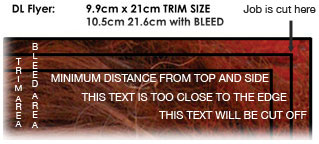Bleed is the most important and least understood facet of print artwork, and yet it is a very simple concept.
When you have a stack of printed paper, it must be trimmed to size. There MUST be 3mm bleed on each edge + an extra 3mm margin for error on each edge.
The paper is clamped and a guillotine edge forced down onto the paper at the trim edge point. As the guillotine is pushed down, the point at which it cuts the paper will vary by a very small amount – this creep or slippage is why we need bleed.

The diagram above shows a corner of a DL document. You will see 3 black lines; the outer is the edge of your artwork, and the innermost line shows the minimum distance for text & content from the edge. The black line between the two is the trim line where the cutter aims for. The bleed exists for two reasons. As the cut aims for the exact trim edge, the cutter may move further out or in. If it moves out, if you do not have your background extending out into the lighter area, your document will end up with a blank edge – which looks messy. If it moves in, any text that butted right up to the trim edge would be compromised. Also, text right to the edge of the trim line looks odd in most cases. Keeping your text 3-5mm or more from the trim edge will keep your document neat.
Bleed also allows us to make double cuts, therefore when batch work is cut down we don’t run the risk of having a sliver of another design on either edge of your print work.
